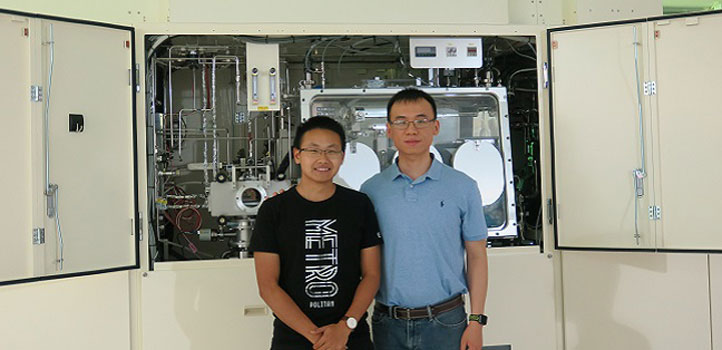Electrical Engineering
Taking control at the junction
Fine tuning the composition of nitride alloys can further the development of optical and electronic interface devices.

Controlling the electronic properties at the interface between materials could help in the quest for improvements in computer memory. KAUST researchers show that varying the atomic composition of boron-nitride-based alloys enables tuning of an important electronic property known as polarization.
When an electric field is applied to a single atom, it shifts the center of mass of the cloud of negatively charged electrons away from the positively charged nucleus it surrounds. In a crystalline solid, these so-called electric dipoles of all atoms combine to create electric polarization.
Some materials exhibit a spontaneous polarization, even without an external electric field. Such materials have potential uses in computer memory, however, this application requires a material system in which the polarization is controllable. Visiting Student Research Program (VSRP) student Kaikai Liu, his supervisor Xiaohang Li and coworkers investigated one approach to polarization engineering at the interface between boron-nitride-based alloys.
Spontaneous polarization is strongly dependent on the structure and composition of the atomic crystal. Some materials, known as piezoelectrics, can change polarization when physically deformed.
The KAUST team used software called the Vienna ab initio Simulation Package to investigate the electronic properties of the ternary alloys boron aluminum nitride and boron gallium nitride. They looked at how they change as boron replaces aluminum and gallium atoms, respectively. “We calculated the spontaneous polarization and piezoelectric constants of boron nitride alloys within a newly proposed theoretical framework and the impact of the polarization at junctions of these two materials,” says Liu.
The team showed that the spontaneous polarization changes very nonlinearly with increasing boron content; this contradicts previous studies that assume a linear relationship.
The reason for this nonlinearity is attributed to the volume deformation of the alloy’s unusual atomic structure, known as wurtzite. The nonlinear change of the piezoelectric polarization is less pronounced, but evident. This arises because of the large difference in atomic spacing between boron nitride and both aluminum nitride and gallium nitride. Furthermore, boron aluminum nitride or boron gallium nitride can become nonpiezoelectric when the boron content is more than 87 percent and 74 percent, respectively.
This work shows that a large range of spontaneous and piezoelectric polarization constants could be made available simply by changing the boron content. This could be useful for developing optical and electronic junction devices formed at the interface between conventional nitride semiconductors and either boron aluminum nitride or boron gallium nitride.
“Our next step will be to experimentally test the proposed junctions, which our theory predicts could have much better device performance than current approaches,” says Liu.
References
- Liu, K., Sun, H., AlQatari, F., Guo, W., Liu, X., Li, J., Torres Castanedo, C. G. & Li, X. Wurtzite BAlN and BGaN alloys for heterointerface polarization engineering. Applied Physics Letters 111, 222106 (2017).| article
You might also like

Bioengineering
Smart patch detects allergies before symptoms strike

Computer Science
Green quantum computing takes to the skies

Electrical Engineering
Micro-LEDs boost random number generation

Bioengineering
Sensing stress to keep plants safe

Computer Science
Sweat-sniffing sensor could make workouts smarter

Electrical Engineering
New tech detects dehydration by touching a screen

Electrical Engineering
A new interface for efficient electronics

Electrical Engineering



